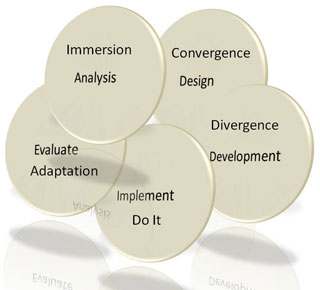This is the fifth post in a series on extending ADDIE in order to solve wicked or complex problems:
- Post 1: Innovating With ADDIE
- Post 2: Analysis and Immersion
- Post 3: Design and Convergence
- Post 4: Development and Divergence

Evaluation in ADDIE is normally composed of two parts:
- Formative Evaluations: a method of judging the worth of a program while the program activities are forming in order to make on-the-spot corrections.
- Summative Evaluations: a method of judging the worth of a program at the end of its activities (summation), with the focus being on the outcome.
In addition, perhaps the most popular methodology for evaluations is Donald Kirkpatrick's Four Level Evaluation Model.
Frog Design's Adaptation is less of a formal approach and more of a causal approach — "stepping back and looking for new directions to go." Wicked or complex problems often have no clear directions when it comes to improving the initial solution, thus you simply take another crack at it to see if you can add new or better functionalities. Evaluation and Adaptation could be scaled as:

The point that you wound up on the first continuum of Analysis and Immersion will more than likely determine the point that you should be on this continuum. That is, if you are working on a simple to complex problem, then you will normally use an Evaluation technique to check your initial solution (left side of continuum). However, if you are working on a complicated to complex problem (wicked problem), then you will normally be to the right of the scale and thus use Adaptation to check your solution.
Next up, final wrap-up on innovating with ADDIE by using Immersion, Convergence, Divergence, and Adaptation.
No comments:
Post a Comment